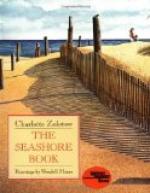Another bird of our coast is the Oyster-catcher, sometimes called the “Sea-pie” or Mussel-picker. These names suit it well, for it does not live on oysters, but on mussels, limpets and whelks. Of course, these are easily “caught” at low tide; they are not easily eaten, so the Sea-pie has to earn his dinner by hard work. In fact, his beak is often notched by the sharp, hard edges of the shells of these molluscs; and at times, he haunts the low banks of mud and ooze near the sea, and there picks up worms and other soft-bodied animals.
As his name Sea-pie shows, the Oyster-catcher is a black-and-white bird, his under parts being white and upper parts black. His legs and long, straight bill are red. Most birds of the waterside seem to find that black-and-white feathers make a good disguise. Though they would show up plainly on a green field, they are well hidden among the stones along the edge of the water.
The Sea-pie makes no nest, only a hole in the sand or shingle, lined with small stones or shells. The eggs are coloured and marked so that they are hard to see among the stones which surround them. The youngsters wear a fluffy suit of grey, marked with dark streaks and dots; and it takes very sharp eyes indeed to pick them out from the shingle where they crouch.
The Ringed Plover is another bird which loves the sandy, pebbly margin of the sea. Have you ever watched him there? He is not much larger than a plump lark, and he runs quickly along the beach, stooping now and again to pick up the morsels of food which his keen eye detects.
But, all the while, he is watching you with the other eye, for he is a wary little bird, and not to be taken by surprise. If you can get near him, you will notice his rather long yellowish legs, greyish-brown back, and, more than all, the white collar round his neck, and the black band showing on his white chest. Again we see the black-and-white markings which are so useful to the bird of the shore.
Everyone who knows the Ringed Plover loves to watch him. He is one of the daintiest, most fairy-like birds. When he is picking up worms and sand-hoppers on the wet sand he is easily observed. But wait! He flies off and settles on the shingle not far away. You walk nearer, to watch him. Alas! he is gone. You know just where he settled, yet he is gone! He has often played that trick on me.
The secret lies in his grey, white-and-black markings. When our ships were in danger from enemy submarines, our sailors painted them with queer stripes and bars, to make it hard for the enemy to see them. Nature has marked the Ringed Plover on the same plan. The feathers are so coloured and the colours are so arranged that, once among the grey, yellow, black, and white pebbles on the beach, the little bird is invisible. It is as if the earth had swallowed him up.
The eggs, too, are just as hard to find. There is no nest to “give the game away”; and the eggs look just like the pebbles amongst which they are laid. The young ones are protected from their enemies in the same way, and they crouch, as still as death, amid the stones which they so much resemble.




